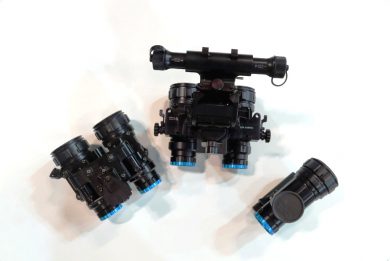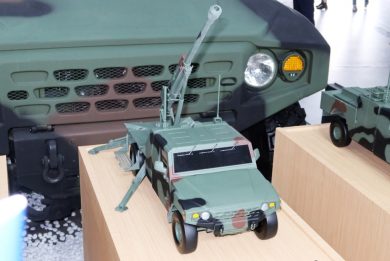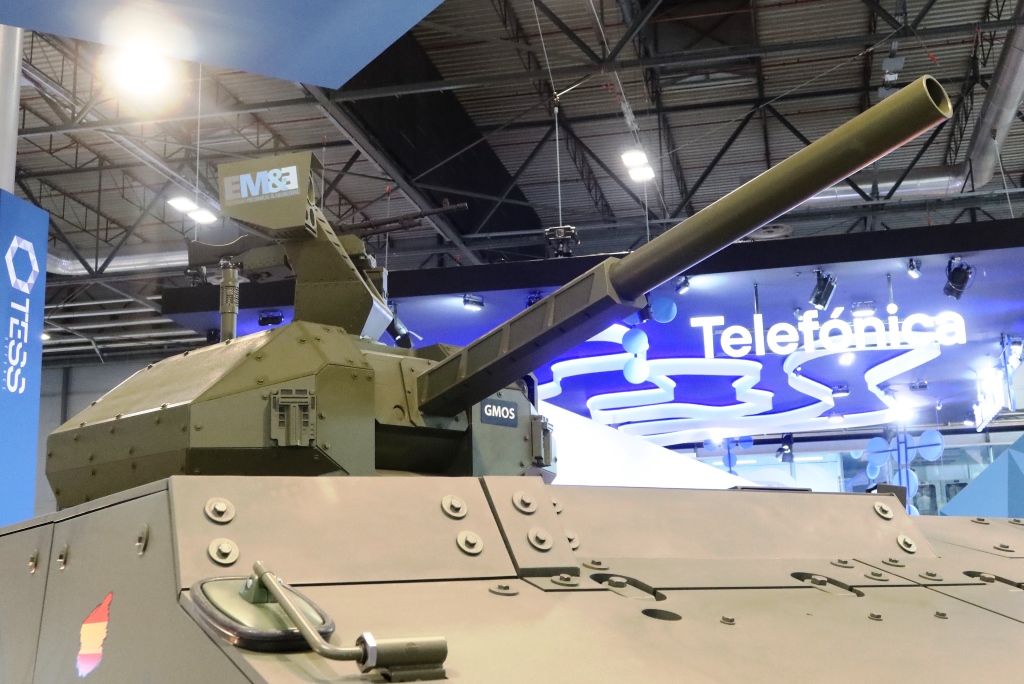
Escribano unveils its new GMOS mortar turret
Escribano, the Spanish turret specialist, unveiled at FEINDEF 2023 its GMOS, a new turret armed with a 120 mm mortar which aims at becoming the standard vehicle-mounted heavy mortar system of the Spanish Army
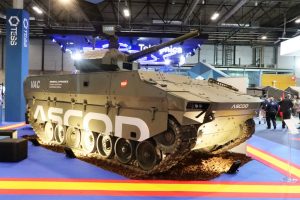
At FEINDEF 2023 the TESS Defence consortium, which includes four of the main Spanish defence companies such as General Dynamics Santa Bárbara Sistemas, Indra, Sapa Plasencia, and Escribano Mechanical & Engineering, unveiled the VAC (Vehículo de Apoyo a Cadenas, tracked support vehicle). The consortium, which was formed years ago to carry out the VCR 8×8 Dragon programme, has now developed the VAC as the replacement for the M113 support vehicles family, known in Spain as TOA (Transporte Oruga Acorazado, tracked armoured transport vehicle). Among the numerous variants the TOA Mortero is the one armed with an L-65/120 mm smoothbore mortar produced by Esperanza y Cia.
The TOA Mortero has the typical layout with the muzzle-loaded mortar installed on a turntable on the vehicle floor; when moving the roof is closet by a hatch, while when in operation the hatch opens to allow firing, leaving however the crew exposed to counter-battery firing. With constant improvements in sensors, such as battlefield radars and airborne optronics installed on UAVs, the time for counter-battery firing has been dramatically reduced, increasing the ranger for mortar crews. Hence the decision to adopt a different solution, that of a breech-loaded mortar installed into a turret, which brought Escribano, one of the Spanish rising defence companies involved among other in turrets and weapon stations production, to develop the GMOS, the acronym standing for Guardian MOrtar System, Guardian being the brand of the company medium calibre turrets.
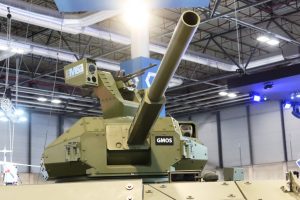
The GMOS weighs less than 1,850 kg, without weapon and ammunition, and as standard is armed with a 120 mm mortar, however an 81 mm weapon can also be installed. The mortar is stabilised in elevation and azimuth with a 1 mrad accuracy, which allows the GMOS to fire on the move when used in the direct fire mode. This is allowed by the optronic aiming suite, which is installed to the right of the mortar. Being Escribano fully involved in thermal sights and stabilised systems, this is mostly an in-house product and features a cooled Medium Wave IR 3rd generation camera with a 640 x 512 matrix with a 15 µm pitch and a x20 continuous zoom that provides a 1.83° x 1.47° narrow field of view and a 36° x 29° wide field of view. The daylight channel is based on a 1920 x 1080 pixels CMOS matrix, which continuous x20 zoom provides a 1.80° x 1.07° narrow field of view and a 38.13° x 21.38° wide field of view. Detection, recognition and identification ranges being respectively over 19.3 km, 11.8 km and 7.3 km with the thermal channel and over 14.3 km, 12.5 km and 10.4 km with the day channel, against the standard 2.3×2.3 metres NATO target. A laser rangefinder with a minimum measuring range of 50 metres and a maximum of 1,500 metres, working in the 1,500 nm band and with± 1 metre accuracy completes the optronic suite. As we can see the rangefinder has a range compatible with the use of a smoothbore mortar in direct fire, which range is limited. The onboard ballistic computer can obviously manage also indirect fire missions, which are the core business of the GMOS, and can receive target data from the C4I system, which is usually provided by the customer.
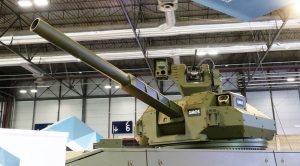
The GMOS is fitted with an autoloader that allows a maximum rate of fire of 10 rounds per minute, one every six seconds, while sustaimed rate of fire is 4 rounds per minute. The fire control computer permitting to fire them in the Multiple Round Simultaneous Impact (MRSI) mode; this allows a limited number of rounds, usually 4-5, to fall at the same instant on the same target exploiting different ballistic trajectories thanks to the considerable maximum elevation, 85°, minimum elevation being –5°; in this mode the terminal effect is increased, although it is not possible to fully exploit the system maximum range, which for the GMOS is around 10 km. No data are provided on protection level, however the turret seems designed to accept add-on armour kits to increase protection.
For self-protection, on top of the GMOS we find an Escribano ASPIS remotely controlled weapon station; this can be armed with a 7.62×51 mm machine gun, such as a conventional M240 or a Dillon M134D Gatling, the latter providing a much higher rate of fire. Fed from the right, the optronic package including an uncooled thermal imager and a daylight CMOS channel, respectively with a x3 discrete and a x30 continuous zoom, and with a 3.3 km laser rangefinder, is located on the left. This further adds to the situational awareness, allowing the commander and gunner to survey different sectors. The ASPIS weighs less than 100 kg without weapon and ammunition.
Escribano aims at providing its GMOS turret not only on VACs in the mortar carrier configuration, but also on the Dragon 8×8, providing organic indirect short-range fire support to heavy and medium infantry units of the Ejercito de Tierra.
Photos by P. Valpolini

